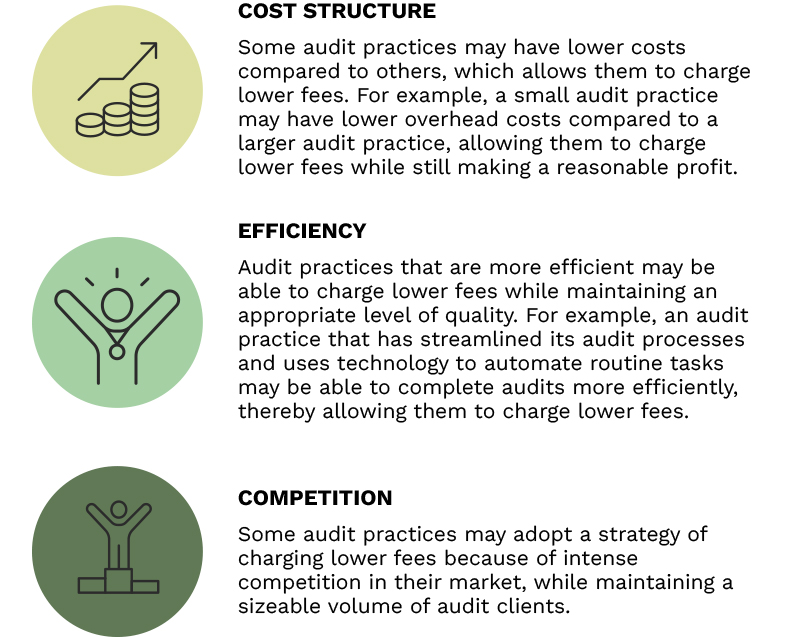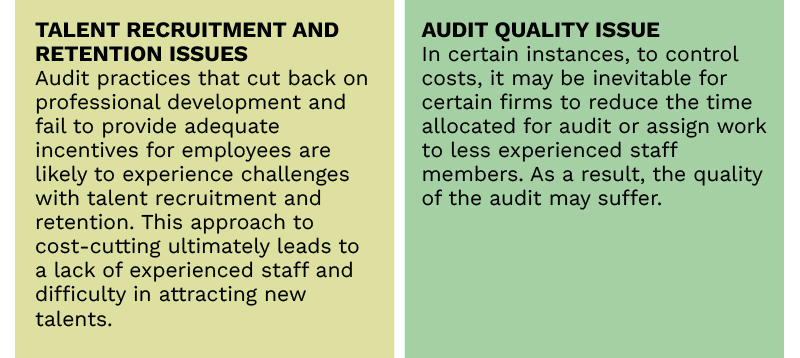By MIA Professional Practices & Technical Team
The potential increase in audit exemption thresholds has sparked a debate within the auditing community, leading to two schools of thought regarding its impact on audit fees. One perspective is that audit exemption will increase the value of audits for the clients who still require them. As fewer companies are mandated to undergo audits, the perceived value and importance of an audit for those who opt to retain audit voluntarily may increase. This positive perception of value may enable auditors to command higher fees.
Conversely, another view posits that audit exemption may intensify competition among small audit firms. With a reduced number of mandatory audit engagements, small and medium-sized audit firms may compete more fiercely for the remaining clients, potentially driving down audit fees. This increased competition could lead to more competitive pricing, offering clients greater value in order to retain and grow their client base. As a result, while some firms may succeed in raising the perceived value of audits and maintaining or even increasing their fees, others might adjust their pricing to stay competitive. Both perspectives underscore the need for audit firms to carefully strategise their fee structures and service offerings in response to the changing landscape. Whether focusing on demonstrating an increase in perceived value or navigating heightened competition, audit practices must ensure their fees are sufficient to cover costs and sustain quality.
Charging the right fee
Provisions under MIA By-Laws (On Professional Ethics, Conduct and Practice)
According to MIA By-Laws Section 330 Fees and Other Types of Remuneration, the level and nature of fee and other remuneration arrangements may create a self-interest threat to compliance with one or more of the fundamental principles. The level of fees may impact a professional accountant’s ability to perform professional services in accordance with technical and professional standards.
A professional accountant should quote an appropriate fee. Quoting a fee lower than another accountant is not in itself unethical. However, the level of fees quoted may create a self-interest threat to compliance with the principle of professional competence and due care if the fee quoted is so low that it may be difficult to perform the engagement in accordance with applicable technical and professional standards.
In accordance with Section 330.3 A2 MY, fees charged for all engagements should be a fair reflection of the value of the work involved and take into account, among others:

Fee-related Considerations for New or Merged Firms
When setting up or merging firms, one crucial consideration that new entrants and growing firms must not overlook is the charging of fees. The fees charged by an audit practice depend on several factors, including the size and complexity of the client, the risk associated with the engagement, and the composition of the engagement team. Therefore, it is essential to conduct a thorough analysis of these factors before quoting a fee.
- Understand the cost structure
Audit practices should have a good understanding of their cost structure, including direct costs (e.g., payroll costs, training and development costs, and overhead costs) and indirect costs (e.g., administrative expenses, utilities, and transportation costs). By understanding the cost structure, audit practices can accurately calculate the total cost of conducting an audit and set a fee that covers their costs and provides a reasonable profit margin. - Conduct a comprehensive scoping exercise
It is essential to conduct a scoping exercise at the outset of an audit engagement to understand the scope of work required and the level of risk involved. This will help the audit practice determine the appropriate fee to charge for the engagement. - Consider the level of expertise required
The fee charged for an audit engagement should reflect the level of expertise required to conduct the audit. More complex audits may require more experienced auditors, and the fee should reflect this additional expertise. - Evaluate the client’s industry and risk profile
The fee charged for an audit engagement should reflect the level of risk associated with the client’s industry and operations. Higher risk clients may require more extensive audit procedures, and the fee would normally reflect this additional work. - Evaluate the competition
Audit practices should conduct market research to understand the fees charged by their competitors for similar audit engagements. This will help them set a fee that is competitive and reflects the value they provide to their clients. - Be transparent with clients
Audit practices should be transparent with their clients about the fee structure and the scope of work required for the audit engagement. This will help manage client expectations and avoid disputes over fees.
Some practitioners may be able to charge lower fees due to a variety of reasons:

While charging lower fees may be advantageous for some audit practices, it is important to ensure that the fees charged cover the costs of conducting the audit and provide a reasonable profit margin.
Implications of Not Charging the Right Fee
The audit fees charged by an audit practice play a crucial role in sustaining the practice. If the fees charged are inadequate, the practice may not be able to cover its costs, which can lead to a host of issues, including talent recruitment and retention issues and compromised audit quality.

Understanding the Impact of the Potential Increase in Audit Exemption Threshold on Practitioners
The upcoming potential increase in the audit exemption threshold is a topic of significant interest and importance for practitioners. This change could have wide-ranging implications on how firms operate, particularly in terms of pricing and cost structures. Understanding these impacts is crucial for practitioners to adapt and maintain their competitive edge.
Potential Changes in Market Demand
One of the primary effects of increased audit exemption thresholds is the potential shift in market demand for audit services. As more companies become exempt from mandatory audits, the overall demand for these services may decrease. Practitioners need to be aware of this potential decline and consider how it might affect their client base and revenue streams. Diversifying services and moving up the value chain of professional services could be key strategies to mitigate this impact.
Practitioners can explore new service offerings that cater to the evolving needs of their clients. For instance, advisory services, compliance assistance, and financial consulting could become more prominent in a firm’s portfolio. By anticipating clients’ needs and developing innovative solutions, practitioners can create new revenue streams and bolster client relationships.
Pricing Adjustments
With changes in demand, pricing strategies will also need to be revisited. Practitioners must evaluate how the increase in the audit exemption threshold will affect their pricing models. For some, this may mean lowering fees to remain competitive. Others might focus on offering bundled services or value-added solutions. It is essential to conduct thorough market research and adjust pricing structures to align with the new regime.
Cost Structure Considerations
The potential decrease in demand for audit services could also necessitate a re-evaluation of cost structures. Practitioners should examine their operational costs and identify areas where efficiencies can be gained. This may involve investing in technology to automate certain processes, reducing overhead costs, or re-negotiating contracts with suppliers. Streamlining operations can help maintain profitability even with reduced demand for conventional audit services.
Client Education and Communication
Educating clients about the implications of the increase in audit exemption thresholds is another critical aspect. Practitioners should proactively communicate with their clients to explain how the changes might affect them and what alternative services could be beneficial. Companies need to assess their business growth trajectory, balancing the potential benefits of exemption against the risk of incurring substantial audit costs to perform work on opening balances, if they no longer qualify for exemption. Auditors can assist in providing tailored advice to clients, guiding them towards the most suitable decision based on their individual circumstances and aspirations. This open communication fosters trust and helps clients understand the value of continuing their relationship with the firm, even if their audit requirements change.
Conclusion
The potential increase in the audit exemption thresholds is a significant development that practitioners must navigate carefully. By understanding how it will impact market demand, pricing strategies, cost structures, and client relationships, firms can proactively adapt to the changing landscape. Embracing innovation and maintaining open communication with clients will be key to thriving in this new environment. Practitioners who approach these changes strategically will be better positioned to sustain and grow their businesses in the face of evolving regulatory requirements.
Building on this foundation, Part 2 delves into strategies to manage audit practices effectively without compromising quality.







